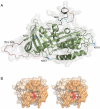N-glycans of human protein C inhibitor: tissue-specific expression and function
- PMID: 22205989
- PMCID: PMC3242763
- DOI: 10.1371/journal.pone.0029011
N-glycans of human protein C inhibitor: tissue-specific expression and function
Abstract
Protein C inhibitor (PCI) is a serpin type of serine protease inhibitor that is found in many tissues and fluids in human, including blood plasma, seminal plasma and urine. This inhibitor displays an unusually broad protease specificity compared with other serpins. Previous studies have shown that the N-glycan(s) and the NH₂-terminus affect some blood-related functions of PCI. In this study, we have for the first time determined the N-glycan profile of seminal plasma PCI, by mass spectrometry. The N-glycan structures differed markedly compared with those of both blood-derived and urinary PCI, providing evidence that the N-glycans of PCI are expressed in a tissue-specific manner. The most abundant structure (m/z 2592.9) had a composition of Fuc₃Hex₅HexNAc₄, consistent with a core fucosylated bi-antennary glycan with terminal Lewis(x). A major serine protease in semen, prostate specific antigen (PSA), was used to evaluate the effects of N-glycans and the NH₂-terminus on a PCI function related to the reproductive tract. Second-order rate constants for PSA inhibition by PCI were 4.3±0.2 and 4.1±0.5 M⁻¹ s⁻¹ for the natural full-length PCI and a form lacking six amino acids at the NH₂-terminus, respectively, whereas these constants were 4.8±0.1 and 29±7 M⁻¹ s⁻¹ for the corresponding PNGase F-treated forms. The 7-8-fold higher rate constants obtained when both the N-glycans and the NH₂-terminus had been removed suggest that these structures jointly affect the rate of PSA inhibition, presumably by together hindering conformational changes of PCI required to bind to the catalytic pocket of PSA.
Conflict of interest statement
Figures







Similar articles
-
Complex formation between protein C inhibitor and prostate-specific antigen in vitro and in human semen.Eur J Biochem. 1994 Feb 15;220(1):45-53. doi: 10.1111/j.1432-1033.1994.tb18597.x. Eur J Biochem. 1994. PMID: 7509746
-
N-glycans and the N terminus of protein C inhibitor affect the cofactor-enhanced rates of thrombin inhibition.J Biol Chem. 2008 Jul 4;283(27):18601-11. doi: 10.1074/jbc.M800608200. Epub 2008 May 8. J Biol Chem. 2008. PMID: 18467335
-
Characterization of semenogelin II and its molecular interaction with prostate-specific antigen and protein C inhibitor.Eur J Biochem. 1996 May 15;238(1):88-96. doi: 10.1111/j.1432-1033.1996.0088q.x. Eur J Biochem. 1996. PMID: 8665956
-
The role of protein C inhibitor in human reproduction.Semin Thromb Hemost. 2007 Feb;33(1):41-5. doi: 10.1055/s-2006-958460. Semin Thromb Hemost. 2007. PMID: 17253188 Review.
-
The interaction among protein C inhibitor, prostate-specific antigen, and the semenogelin system.Semin Thromb Hemost. 2007 Feb;33(1):46-52. doi: 10.1055/s-2006-958461. Semin Thromb Hemost. 2007. PMID: 17253189 Review.
Cited by
-
Tumor biomarker glycoproteins in the seminal plasma of healthy human males are endogenous ligands for DC-SIGN.Mol Cell Proteomics. 2012 Jan;11(1):M111.008730. doi: 10.1074/mcp.M111.008730. Epub 2011 Oct 10. Mol Cell Proteomics. 2012. PMID: 21986992 Free PMC article.
-
Expression of SERPINA3s in cattle: focus on bovSERPINA3-7 reveals specific involvement in skeletal muscle.Open Biol. 2015 Sep;5(9):150071. doi: 10.1098/rsob.150071. Open Biol. 2015. PMID: 26562931 Free PMC article.
-
Site-specific glycoforms of haptoglobin in liver cirrhosis and hepatocellular carcinoma.Mol Cell Proteomics. 2013 May;12(5):1281-93. doi: 10.1074/mcp.M112.023259. Epub 2013 Feb 6. Mol Cell Proteomics. 2013. PMID: 23389049 Free PMC article.
-
Regulation of epidermal barrier function and pathogenesis of psoriasis by serine protease inhibitors.Front Immunol. 2024 Dec 16;15:1498067. doi: 10.3389/fimmu.2024.1498067. eCollection 2024. Front Immunol. 2024. PMID: 39737188 Free PMC article. Review.
-
Ovarian cyst fluid is a rich proteome resource for detection of new tumor biomarkers.Clin Proteomics. 2012 Dec 27;9(1):14. doi: 10.1186/1559-0275-9-14. Clin Proteomics. 2012. PMID: 23268721 Free PMC article.
References
-
- Suzuki K. The multi-functional serpin, protein C inhibitor: beyond thrombosis and hemostasis. J Thromb Haemost. 2008;6:2017–2026. - PubMed
-
- Espana F, Sanchez-Cuenca J, Fernandez PJ, Gilabert J, Romeu A, et al. Inhibition of human sperm-zona-free hamster oocyte binding and penetration by protein C inhibitor. Andrologia. 1999;31:217–223. - PubMed
-
- Espana F, Gilabert J, Estelles A, Romeu A, Aznar J, et al. Functionally active protein C inhibitor/plasminogen activator inhibitor-3 (PCI/PAI-3) is secreted in seminal vesicles, occurs at high concentrations in human seminal plasma and complexes with prostate-specific antigen. Thromb Res. 1991;64:309–320. - PubMed
-
- Christensson A, Lilja H. Complex formation between protein C inhibitor and prostate-specific antigen in vitro and in human semen. Eur J Biochem. 1994;220:45–53. - PubMed
Publication types
MeSH terms
Substances
Grants and funding
LinkOut - more resources
Full Text Sources
Research Materials
Miscellaneous

